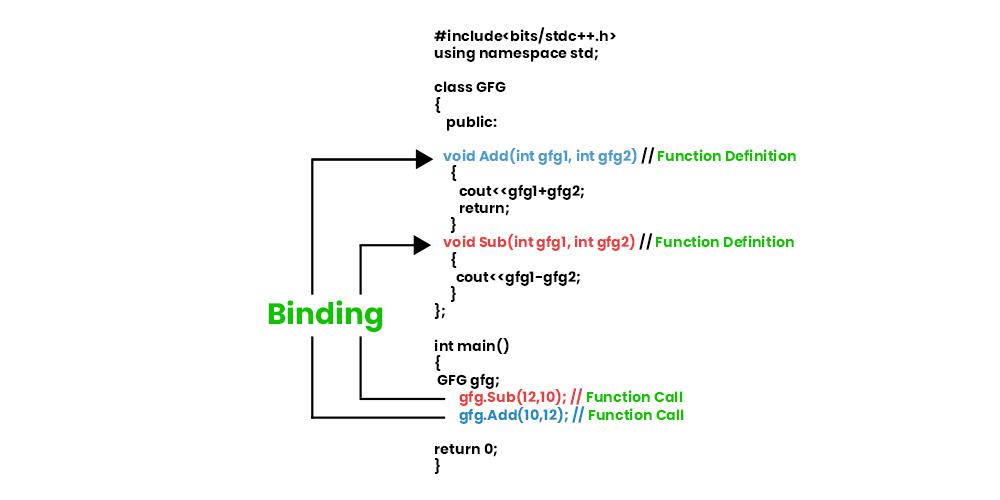Dynamic Binding in C++
Last Updated :
23 Aug, 2023
Dynamic binding in C++ is a practice of connecting the function calls with the function definitions by avoiding the issues with static binding, which occurred at build time. Because dynamic binding is flexible, it avoids the drawbacks of static binding, which connected the function call and definition at build time.
In simple terms, Dynamic binding is the connection between the function declaration and the function call.

Dynamic Binding in C++
So, choosing a certain function to run up until runtime is what is meant by the term Dynamic binding. A function will be invoked depending on the kind of item.
Usage of Dynamic Binding
It is also possible to use dynamic binding with a single function name to handle multiple objects. Debugging the code and errors is also made easier and complexity is reduced with the help of Dynamic Binding.
Static Binding Vs Dynamic Binding
|
Static Binding
|
Dynamic Binding
|
| It takes place at compile time which is referred to as early binding |
It takes place at runtime so it is referred to as late binding |
| Execution of static binding is faster than dynamic binding because of all the information needed to call a function. |
Execution of dynamic binding is slower than static binding because the function call is not resolved until runtime. |
| It takes place using normal function calls, operator overloading, and function overloading. |
It takes place using virtual functions |
| Real objects never use static binding |
Real objects use dynamic binding |
Virtual functions
A virtual function is a member function declared in a base class and re-declared in a derived class (overridden). You can execute the virtual function of the derived class when you refer to its object using a pointer or reference to the base class. The concept of dynamic binding is implemented with the help of virtual functions.
Example:
C++
#include <bits/stdc++.h>
using namespace std;
class GFG {
public:
void Add(int gfg1, int gfg2)
{
cout << gfg1 + gfg2 << endl;
return;
}
void Sub(int gfg1, int gfg2) { cout << gfg1 - gfg2; }
};
int main()
{
GFG gfg;
gfg.Add(10, 12);
gfg.Sub(12, 10);
return 0;
}
|
Example:
C++
#include <iostream>
using namespace std;
class GFG {
public:
void call_Function() { print(); }
virtual void print()
{
cout << "Printing the Base class Content" << endl;
}
};
class GFG2 : public GFG {
public:
void print()
{
cout << "Printing the Derived class Content"
<< endl;
}
};
int main()
{
GFG geeksforgeeks;
geeksforgeeks.call_Function();
GFG2 geeksforgeeks2;
geeksforgeeks2.call_Function();
return 0;
}
|
Output
Printing the Base class Content
Printing the Derived class Content
Like Article
Suggest improvement
Share your thoughts in the comments
Please Login to comment...